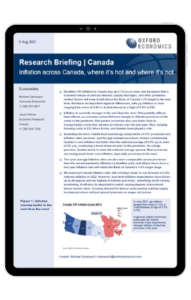Canada | Inflation across Canada, where it’s hot and where it’s not

Headline CPI inflation in Canada was up 3.1% y/y in June, and we expect that a transient release of pent-up demand, supply shortages, and other pandemic-related factors will keep it well above the Bank of Canada’s 2% target in the near term. But there are important regional differences, with y/y inflation in June ranging from a low of 1.8% in Saskatchewan to a high of 5.3% in PEI.
What you will learn:
- Inflation is currently stronger in the east than the west. This partially reflects base effects, as consumer prices fell more sharply in Atlantic provinces at the onset of the pandemic. But eastern provinces also saw faster rises in transportation costs than western provinces over the past year.
- Excluding the more volatile food and energy components of CPI, provincial core inflation rates are lower, and the gap between provinces shrinks considerably.
- Two-year average inflation rates are also more comparable across provinces than the current pandemic-affected y/y headline print, and all provinces have a two-year inflation rate well within the Bank of Canada’s 1-3% target range.
Tags:
Related Services

Post
Closing our short SEK trade to capitalise on the Scandi FX sell-off
We expected a bout of SEK weakness following the Riksbank rate cut in the spring, but we think the recent sell-off is overdone, and we close our long EURSEK trade, opened in May.
Find Out More
Post
US Industrial and retail outperform over the next five years
In our recent real estate webinar, we showed that prices started to turn a corner. We predict industrial and retail will record the smallest value declines this year, and over the next five years, apartment and industrial are expected to record the strongest value growth on average. Both sectors are expected to reach their peak values of 2022 this decade.
Find Out More